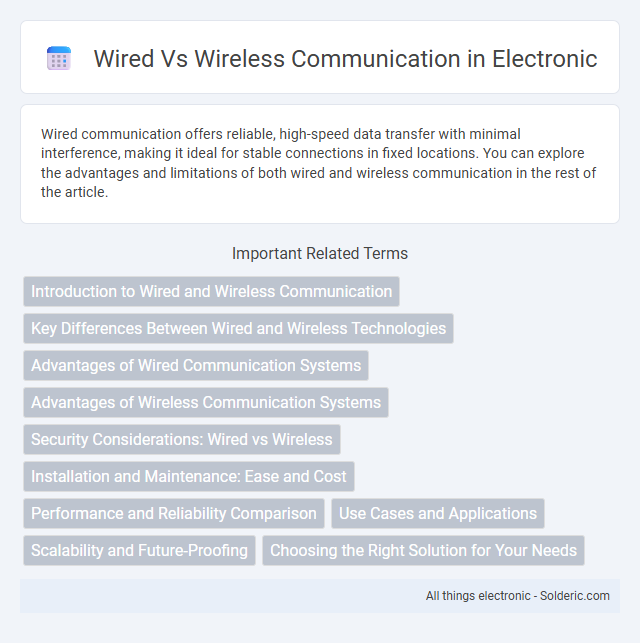Wired communication offers reliable, high-speed data transfer with minimal interference, making it ideal for stable connections in fixed locations. You can explore the advantages and limitations of both wired and wireless communication in the rest of the article.
Comparison Table
| Aspect | Wired Communication | Wireless Communication |
|---|---|---|
| Medium | Cable, fiber optics, copper wires | Radio waves, microwaves, infrared signals |
| Speed | High, stable bandwidth (up to 100 Gbps with fiber optics) | Variable, generally lower than wired (up to 10 Gbps with 5G) |
| Reliability | Highly reliable, less interference | Subject to interference, weather, obstacles |
| Mobility | Limited, fixed connections | Highly mobile, supports device movement |
| Installation Complexity | Complex and costly due to cables and infrastructure | Simpler, no physical cables needed |
| Security | More secure, harder to intercept | Less secure, vulnerable to eavesdropping |
| Cost | Higher initial setup cost, lower maintenance | Lower installation cost, potentially higher maintenance |
| Common Uses | LANs, data centers, fixed telephony | Mobile networks, Wi-Fi, Bluetooth, cellular |
Introduction to Wired and Wireless Communication
Wired communication uses physical cables such as Ethernet or fiber optics to transmit data with high speed and low latency, ensuring reliable and secure connections. Wireless communication relies on radio waves, including Wi-Fi, cellular networks, and Bluetooth, offering mobility and convenience but often facing interference or signal degradation. Understanding the fundamental differences between these methods helps optimize your network setup for performance, security, and flexibility.
Key Differences Between Wired and Wireless Technologies
Wired communication uses physical cables such as Ethernet or fiber optics to transmit data, offering higher stability, faster speeds, and enhanced security compared to wireless methods. Wireless communication relies on radio frequency signals like Wi-Fi, Bluetooth, or cellular networks, providing greater mobility and ease of installation but typically experiencing more interference and latency issues. The choice between wired and wireless technologies depends on specific requirements for speed, reliability, security, and flexibility in a given network infrastructure.
Advantages of Wired Communication Systems
Wired communication systems offer unmatched reliability and security due to their physical connections, which minimize interference and unauthorized access. They provide consistent high-speed data transfer, essential for bandwidth-intensive applications and critical network environments. Your business or home network benefits from stable, low-latency communication that supports seamless performance and robust data integrity.
Advantages of Wireless Communication Systems
Wireless communication systems offer significant advantages including enhanced mobility, allowing users to connect and communicate without physical constraints. These systems facilitate easy installation and scalability, reducing infrastructure costs and enabling rapid deployment in diverse environments. Your connectivity benefits from increased flexibility and accessibility, making wireless solutions ideal for dynamic and remote applications.
Security Considerations: Wired vs Wireless
Wired communication offers enhanced security due to its physical connections, making unauthorized access and interception more difficult compared to wireless networks. Wireless communication is inherently vulnerable to eavesdropping, signal interference, and unauthorized access, requiring robust encryption protocols like WPA3 and secure authentication methods to mitigate risks. Organizations must assess potential threats such as man-in-the-middle attacks and implement network segmentation and intrusion detection systems to protect wireless transmissions.
Installation and Maintenance: Ease and Cost
Wired communication systems generally require higher installation costs due to physical cable laying and infrastructure setup, but they offer lower maintenance expenses over time because of stable connections and fewer signal interferences. Wireless communication installations are typically faster and more cost-effective initially as they eliminate the need for extensive cabling, yet they may incur higher maintenance costs caused by signal disruptions, hardware upgrades, and environmental factors. Evaluating total cost of ownership depends on the specific application, environment, and long-term operational needs.
Performance and Reliability Comparison
Wired communication systems generally offer higher performance and greater reliability due to stable physical connections that minimize interference and latency issues. Wireless communication, while providing flexibility and mobility, often faces challenges such as signal degradation, interference, and variable bandwidth that can affect data transmission quality. Your choice between wired and wireless should consider the need for consistent data integrity and speed versus the benefits of accessibility and convenience.
Use Cases and Applications
Wired communication is ideal for environments demanding consistent high-speed data transfer and enhanced security, such as data centers, corporate networks, and industrial automation systems. Wireless communication excels in mobility-focused applications like remote monitoring, IoT devices, and cellular networks, offering flexibility and ease of installation. Both technologies are pivotal in smart homes, healthcare monitoring, and transportation systems, optimized based on specific use case requirements.
Scalability and Future-Proofing
Wired communication offers limited scalability due to physical cable constraints and installation complexity, making expansion costly and time-consuming. Wireless communication supports greater scalability with easy device additions and flexible network adjustments, accommodating growing user demands and evolving technologies. Your future-proof network benefits from wireless solutions that integrate seamlessly with emerging standards like 5G and Wi-Fi 6, ensuring long-term adaptability.
Choosing the Right Solution for Your Needs
Selecting between wired and wireless communication depends on factors like reliability, speed, security, and mobility requirements. Wired connections, such as Ethernet, offer higher stability, lower latency, and enhanced data protection suitable for fixed installations and high-demand environments. Wireless solutions, including Wi-Fi and Bluetooth, provide flexibility, ease of deployment, and support for mobile devices, making them ideal for dynamic settings or areas where cabling is impractical.
Wired vs Wireless communication Infographic

 solderic.com
solderic.com